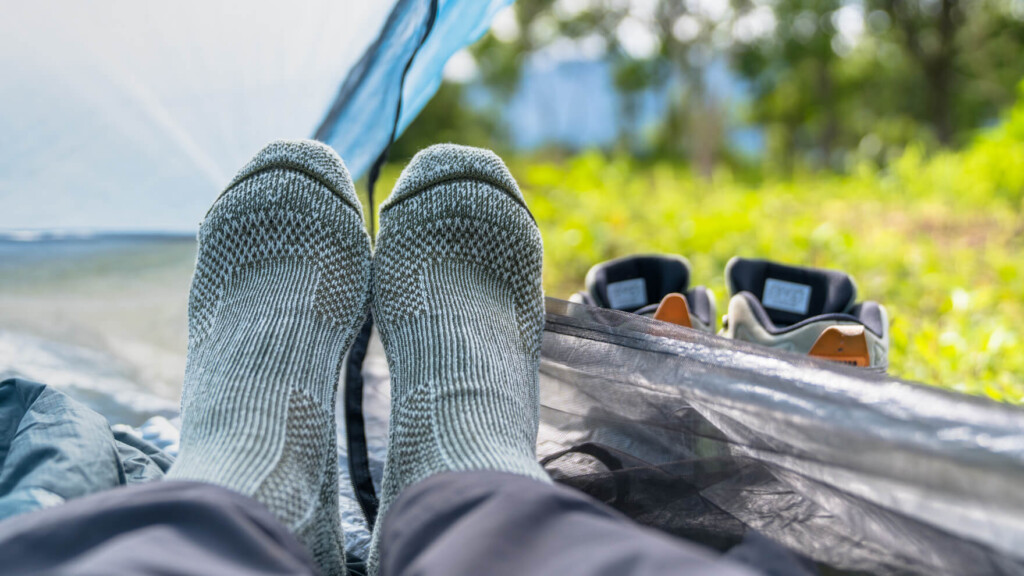
Recommended socks for this season and how to choose wisely, chosen by mountain enthusiasts who have worn over 100 pairs of mountain socks [Complete Guide]
Socks are "unsung heroes" that determine whether you can spend your day comfortably
The socks worn when climbing are key players who play a variety of roles in protecting the area around the feet, such as keeping warm, shock absorption, absorbing and spreading sweat, and protecting the skin. In many cases, changing the socks can solve the comfort, ease of stuffiness, and blisters of boots. In fact, it is such an important item that it can be said that whether you can make the most of your shoes or not depends on the socks, and choosing the socks that are perfect for you is just as important as choosing shoes.
So this time, I've worn over 100 pairs of hiking and trail running socks over the course of 20 years of mountaineering, so I've checked out all the popular, classic and new models this season, and chose the best models to suit my purpose and preferences. In the second half, we'll also summarize some useful points to know about when choosing the best mountaineering socks for you. We hope this will help you find the perfect pair for you from among the mountains of options hanging from the shop.
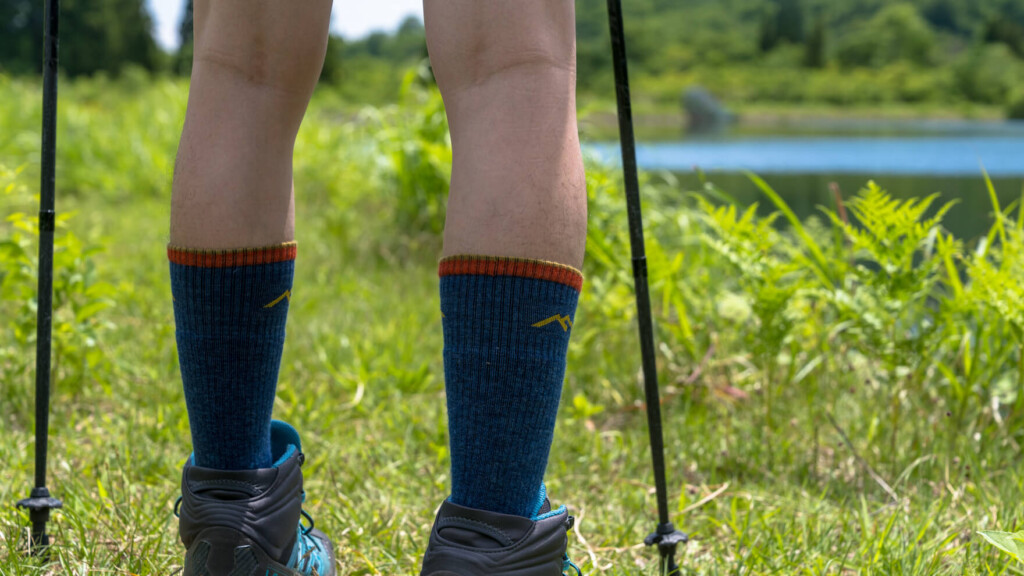
table of contents
- [By category] Best Outdoor Socks of the Season
- Best Hiking (General) category: DARN TOUGH Hiker Boot Sock Midweight Full Cushion/SmartWool Mountainee Extra Cushion Crew/FITS Medium Rugd Crew/Point 6 37.5 Hiking Essential Medium Crew
- Best Fast Packing Division: RXL Socks WILD WOOL [Thickness: Thickness, Length: Long)]
- Best Thin Lightweight Division: Feetures ELITE LIGHT CUSHION MINI CREW
- Best/Front Category: injinji Outdoor Midweight Crew Nou Wool/YAMAtune Outdoor Medium Arch Crew 2toe
- Vest and Shoe Slip Prevention Division: WRIGHTSOCK ADVENTURE
- Best Dry (Smooth and Quick Dry) Division: RXL Socks WILD PAPER Japanese Paper Socks (Round)
- Best Compression Division: YAMAtune Outdoor Medium Arch Crew/SockWell STAMPEDE CREW
- Best Cost Performance Division: HALISON Merino Support Pile Trekking
- How to choose: 5 tips for choosing the perfect mountain climbing and outdoor socks for you
- Point 1: Material: Wool blend for all-purpose athletes, or synthetic fibers that focus on quick drying?
- Point 2: Thickness of the fabric - ensuring the necessary cushioning and warmth -
- Point 3: Length (length) ~The basic length of the crew is
- Point 4: Fit: Greatly affects comfort
- Point 5: Durability - A variety of models, from things that get worn out in one season to models that last forever
- summary
[By category] Best Outdoor Socks of the Season
Best Hiking (General) category: DARN TOUGH Hiker Boot Sock Midweight Full Cushion/SmartWool Mountainee Extra Cushion Crew/FITS Medium Rugd Crew/ Point 6 37.5 Hiking Essential Medium Crew
DARN TOUGH Hiker Boot Sock Midweight Full Cushion
Favorite points
- Comfortable to the touch
- Lifetime guarantee durability
Not very good points
- Cushioning and support for the arch are normal
- It's a bit stuffy
SmartWool Mountaineer Extra Cushion Crew
Favorite points
- Moderate fit and support
- Comfortable to the touch
Not very good points
- Poison is likely to occur slightly

FITS Medium Ragd Crew
Favorite points
- High fit and feel to the touch to create an excellent fit
Not very good points
- (Relatively) low durability
Point 6 37.5 Hiking Essential Medium Crew
Favorite points
- Calculated fit and support
- 37.5 High sweat processing capacity thanks to technology
Not very good points
- The wool is slightly less comfortable
Best Fast Packing Division : RXL Socks WILD WOOL [Thickness: Thickness, Length: Long)]
Favorite points
- The fit is three-dimensionally captures the shape of the foot and moderate stretch
- High durability made from merino wool and Cordura nylon
Not very good points
- Thickest model in the series (relatively) has a reasonable cushioning performance.
Best Thin Lightweight Division: Feetures ELITE LIGHT CUSHION MINI CREW
Favorite points
- Moderate support
- Comfortable for synthetic fibers
Not very good points
- The texture is more rough than wool
Best/Front Category: injinji Outdoor Midweight Crew Nou Wool/YAMAtune Outdoor Medium Arch Crew 2toe
injinji Outdoor midweight crewneau wool
Favorite points
- High quality wool is comfortable to the touch and highly functional
- The fingers are separated, so it is less likely to get stuffy and easy to step on to the fingertips
Not very good points
- It's difficult to put on and take off
YAMAtune Outdoor Medium Arch Crew 2toe
Favorite points
- Strong fit gives the arch of the foot, high support for ankles and heels
- Easy to step on to your fingertips
Not very good points
- Durability to rubbing and washing is slightly less
Vest and Shoe Slip Prevention Division: WRIGHTSOCK ADVENTURE
Favorite points
- The unique double structure makes it difficult to blisters and makes it quick-drying
Not very good points
- Low cushioning
- When you take it off or wash it, it will inevitably twist slightly and is difficult to handle
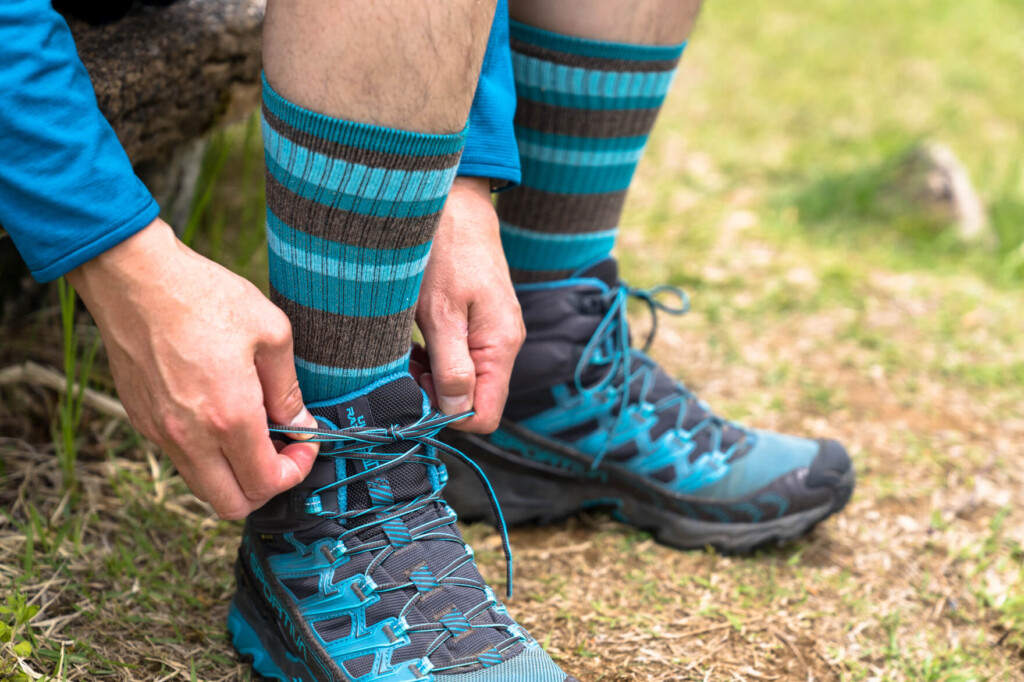
Best Dry (Smooth and Quick Dry) Division: RXL Socks WILD PAPER Japanese Paper Socks (Round)
Favorite points
- Excellent dryness, not easily discomfort even when wet
- Lightweight and quick drying
Not very good points
- The fabric is slippery
- A rough texture
Best Compression Division: YAMAtune Outdoor Medium Arch Crew/SockWell STAMPEDE CREW
YAMAtune Outdoor Medium Arch Crew
Favorite points
- Strong fit gives the arch of the foot, high support for ankles and heels
- Compression on the calves makes it less likely to cause swelling
Not very good points
- The compression power is strong, so wearing it during relaxing hours at night or for long periods of time is tough (for some people).
SockWell STAMPEDE CREW
Favorite points
- Comfortable and functional fit with step-by-step compression
- Merino wool and alpaca fibers make it comfortable to the touch
- Refined design
Not very good points
- The cushioning and breathability are reasonable, so it's not good to use it in a hard way.
Best Cost Performance Division: HALISON Merino Support Pile Trekking
Favorite points
- The pile lining has a comfortable feel and moderate cushioning
- Excellent breathability due to mesh knit at the instep
Not very good points
- The fit is loose
- Scratch resistance
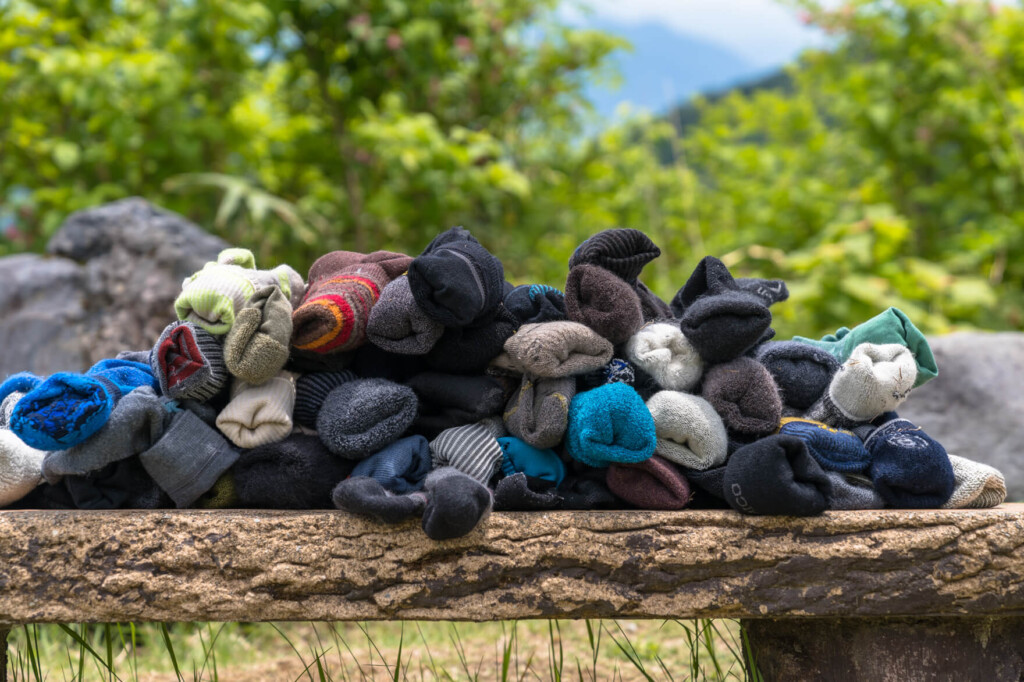
How to choose: 5 tips for choosing the perfect mountain climbing and outdoor socks for you
Point 1: Material: Wool blend for all-purpose athletes, or synthetic fibers that focus on quick drying?
One of the most important points that will affect the performance of socks, from comfort to function, such as feel to the touch, heat retention, and difficulty in getting stuffy, is the first thing to consider when choosing the material.
For example, 100% cotton socks that I wear often on a daily basis are durable and comfortable, but they also tend to get stuffy due to sweat and dries slowly. The feet are concentrated with approximately 250,000 sweat glands called eccrine glands, and since the feet are one of the most prone to sweating in the human body, so socks that are poorly sweaty are not suitable for socks. Once again wet cotton can reduce its heat retention, and in some cases it can even lead to life-threatening.
As such, there are various differences in characteristics depending on the material, and each manufacturer continues to develop a wide variety of models, choosing the material that is suitable for it depending on the purpose and purpose, and sometimes blending it.
The main character is from "synthetic fiber" to "merino wool"
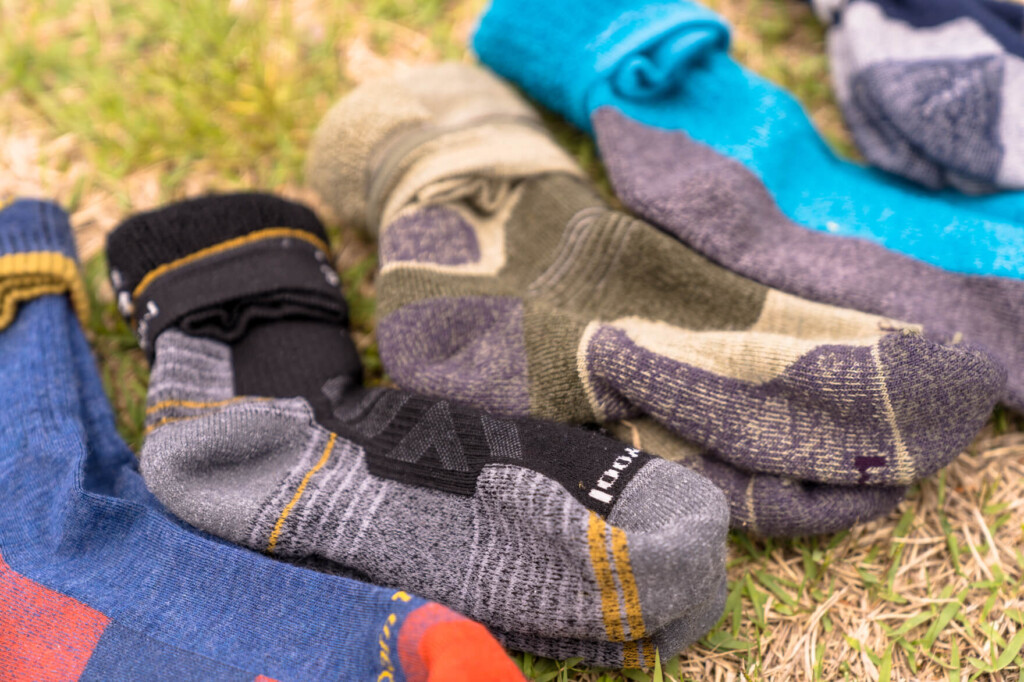
Until a few years ago, synthetic climbing socks, mainly made from polyester and nylon, were common. This is because they dry faster than cotton and are more durable. Furthermore, a blend of synthetic fibers with different advantages, such as more elastic spandex, wool-like acrylic, and quick-drying polypropylene, were created to create small differences.
Later, they featured merino wool hiking socks. Merino wool is a type of sheep that lives in harsh mountainous areas such as New Zealand, and its fibers do not have the tingling sensation of old wool, making it extremely warm, comfortable and durable. It maintains heat retention even when wet, and has excellent moderate breathability, moisture absorption, and temperature regulation, so it has the ability to alleviate situations such as "too hot or too cold" not only in harsh winters and early summers. It also has a natural deodorizing effect and is less likely to release a bad smell no matter how many days you wear it, making it a material that is truly for mountain climbing. Naturally, popularity suddenly exploded, and all outdoor manufacturers began to develop socks that incorporate merino wool.
Socks containing merino wool are no longer uncommon nowadays, and most climbing socks are made of a blend of wool and synthetic fiber. However, the performance difference can vary from pin to sharp depending on the quality of the yarn itself, the blend ratio with synthetic fibers, and how it is knitted, so be careful to make a simplified judgment that it is OK because it is merino wool.
Anyway, if you're looking for socks for cold regions, it's definitely better to choose a model that contains a lot of merino wool. However, if you are aware that you will be hiking in the warm seasons and in the extreme heat, or if you know that you will sweat a lot, a synthetic fiber-based material that focuses on quick drying and breathability is cheaper and more effective.
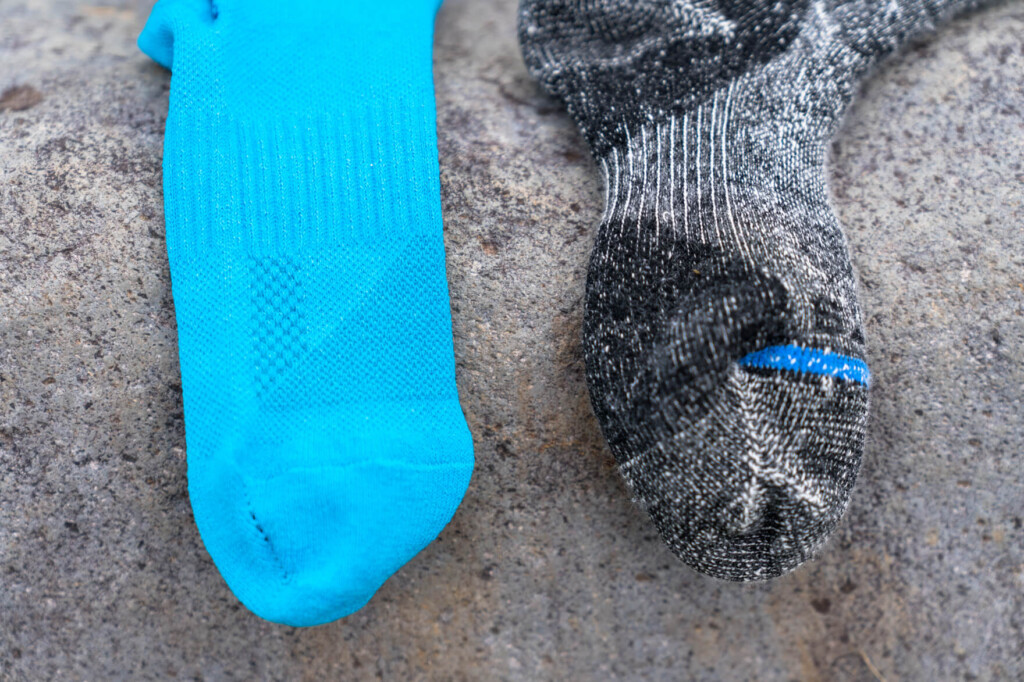
Point 2: Thickness of the fabric - ensuring the necessary cushioning and warmth -
Made from thick fabric, the socks provide the ultimate cushioning and warmth. Also, if there is more space between your feet and shoes than necessary, filling them with socks with appropriate thickness can minimize this deviation. On the other hand, it also has side effects such as a decent weight, bulkiness, ease of stuffiness, and in some cases too hot. For now, there are no versatile socks that fit any activity all year round.
For this reason, common sock brands offer multiple models of hiking socks divided into categories based on thickness, allowing users to choose the weight according to their circumstances and preferences. When purchasing, it is basic to choose the thickness according to the season and purpose, but if that doesn't fit the shoes you actually walk in, we recommend prioritizing a thickness that fits more perfectly.

Note that not all socks are uniformly thick, and some models may have thicknesses on the necessary parts such as the toes and heels, so be careful. Below we will introduce the differences in trends depending on weight.
| material | Light or Ultra Lightweight (thin) | Midweight (medium thick) | Heavy or extra heavy weight (thick) |
|---|---|---|---|
| Thermal insulation | △ | ◯ | ◎ |
| Cushioning | △ | ◯ | ◎ |
| weight | ◎ | ◯ | △ |
| Breathable and quick-drying | ◎ | ◯ | △ |
| Fit and easy to shift | ◎ | ◯ | △ |
| Suitable season | Warm to hot season | Early spring to early winter | Winter |
| Suitable activities |
|
|
|
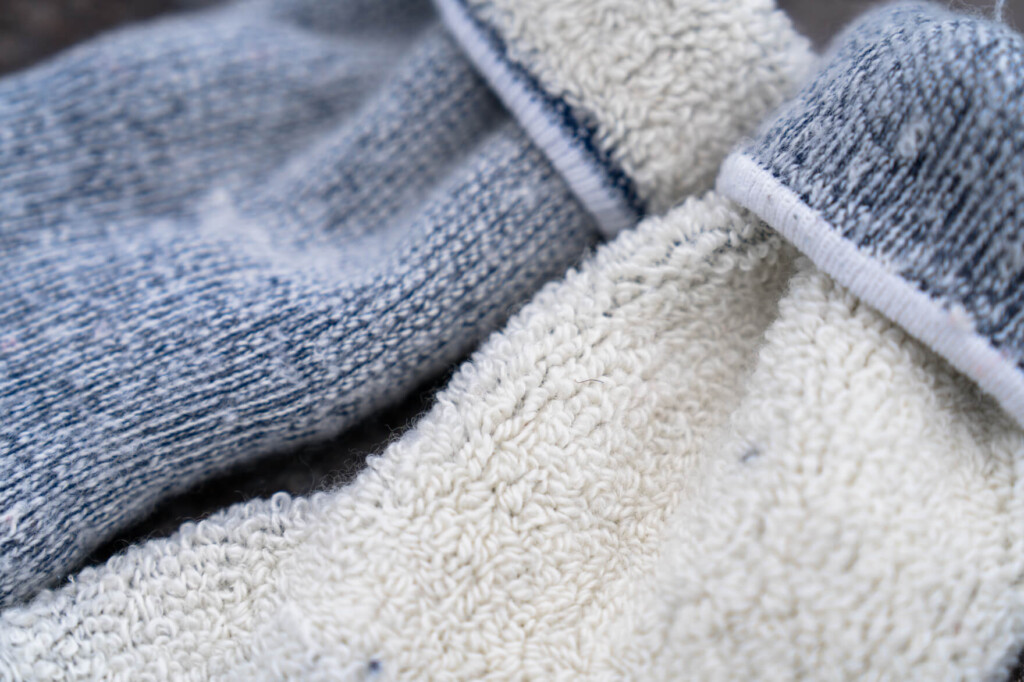
Point 3: Length (length) ~The basic length of the crew is
Just like its thickness, socks come in a variety of lengths (lengths) and can be chosen according to your personal preferences and type of shoes. The terms and length regulations and how to divide them differ slightly depending on the manufacturer, but if you divide them into four categories, they are "no-shows (ankles), ankles (above ankles), crew (half calves), and boots (all calves).

Long socks are matched with high-cut trekking boots, which also improves protection for the shins, but can also be hot during low mountain hikes in the summer.
Conversely, short socks are perfect for day hiking with low-cut hiking shoes on hot summer days. However, if you try to wear mid-cut or high-cut boots, it may not be long enough and may cause blisters. Also, when hiking through tall grass or forest zones with short pants, short socks can also cause injury.
The socks should be at least as tall as the shoes you wear, and unless it's a large, well-maintained trail, we recommend using socks that are as high as possible. Generally, crew length socks are the safest option, and if you choose this size, you can fit any case.
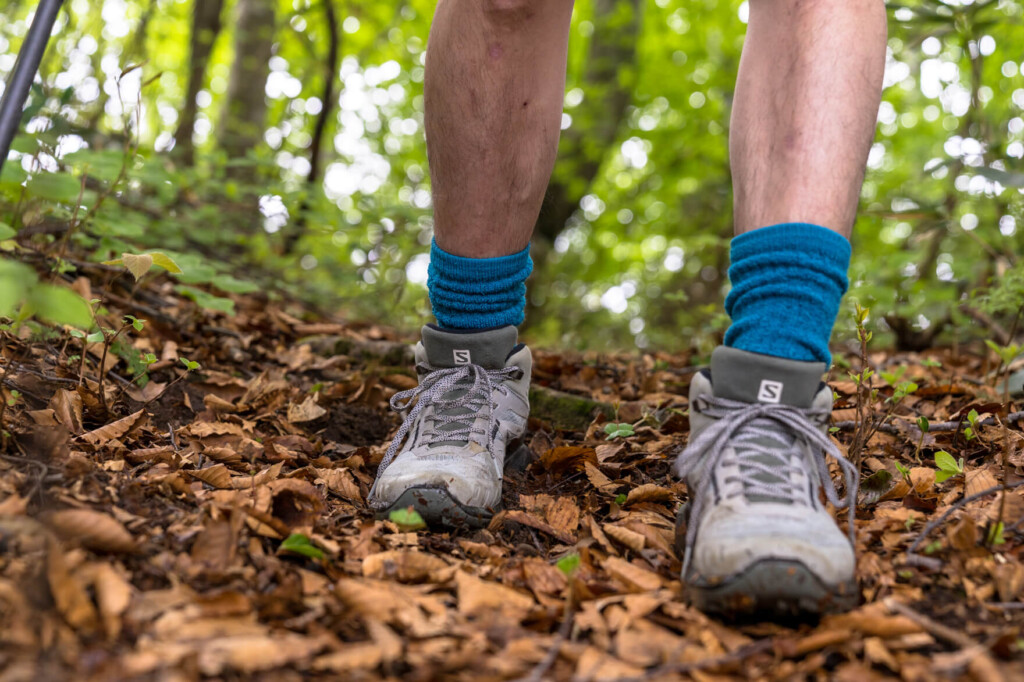
Is liner (layered) effective?
In the day and age when heavy, heavy leather climbing boots were the norm, it was true that many people wore socks twice. The meaning of wearing it twice is often to prevent blisters. The outer socks will support friction with the shoes, and the inner liner socks will not slip and the skin on the feet is safe.
This logic is still not wrong today. However, in today's world, where trekking boots are much lighter and more flexible than before, and many comfortable socks that fit perfectly on one piece, there is no need to be serious about them saying, "If you don't layer them, you'll likely get blisters." For this reason, in today's age, there is no need to actively consider layering.
In fact, the risk of the socks slipping inside the shoes is even more serious because you just layer them on socks in your shoes. If you're going to walk or run lightly, it's best to wear a single, simple style of socks.
Of course, you can still suffer from blisters. Layering is a great solution in such cases. So, consider liner socks to be a last resort for those suffering from blisters and unpleasant friction to consider after trying out synthetic socks that are highly moisture-absorbing wool or fast-drying synthetic socks. The liner socks in this case are as thin as possible, so it is best to pair them with socks that are highly absorbent and quick-drying.
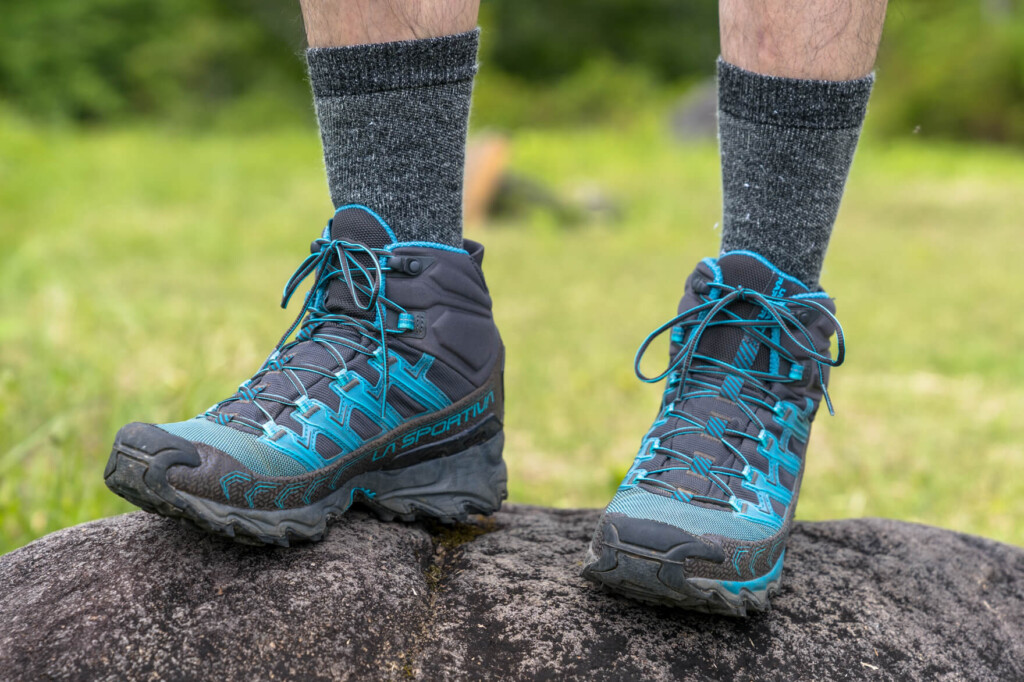
Point 4: Fit: Greatly affects comfort
Of course, excellent materials are essential for good socks, but at the same time, it's essential to fit your feet firmly.
It has a comfortable feel and inconspicuous seams, not too tight or too loose, no partial pressure or slack, and it has a fit that won't slip even if you move your fingertips, step on them hard, or land on your heels. The inside of the shoes while you are active is extremely humid, and the swelling skin is sensitive to scuffs and easily damaged, socks that fit correctly can significantly reduce the risk of beans and discomfort while hiking.
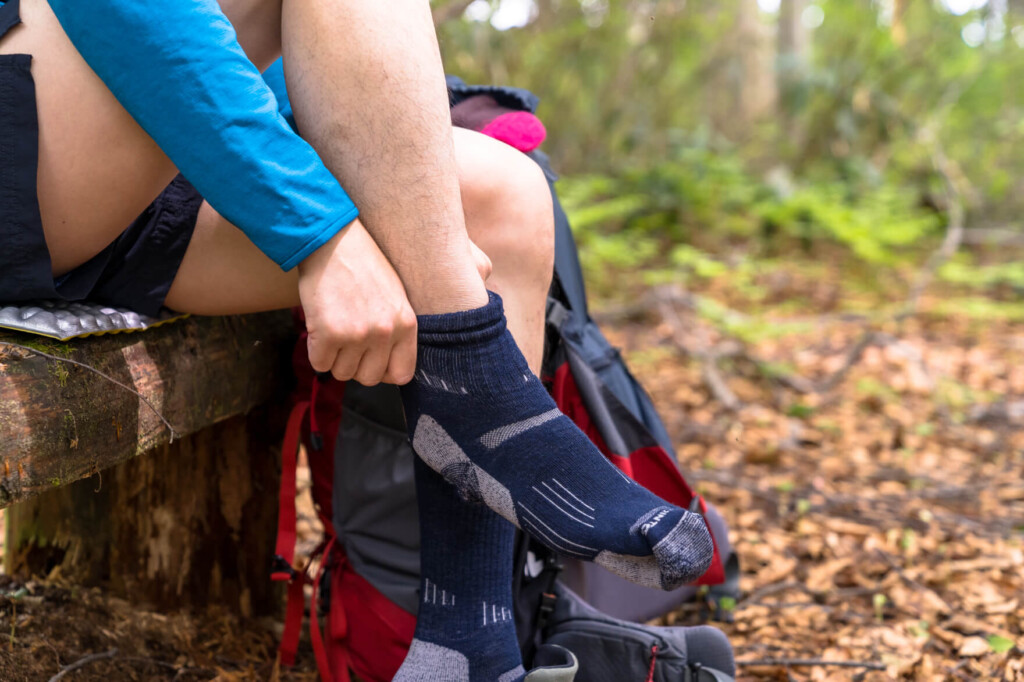
It is not just craftsman-made sewing techniques that will provide excellent fit socks. For example, hiking socks are ergonomically patterned to match the shape of each foot (left of the photo below). Looking at the toes, you can see that asymmetric curves are drawn along the length of each finger. In addition, cutting the shape of the foot in a three-dimensional way reduces stress during movement and improves the fit throughout your actions.
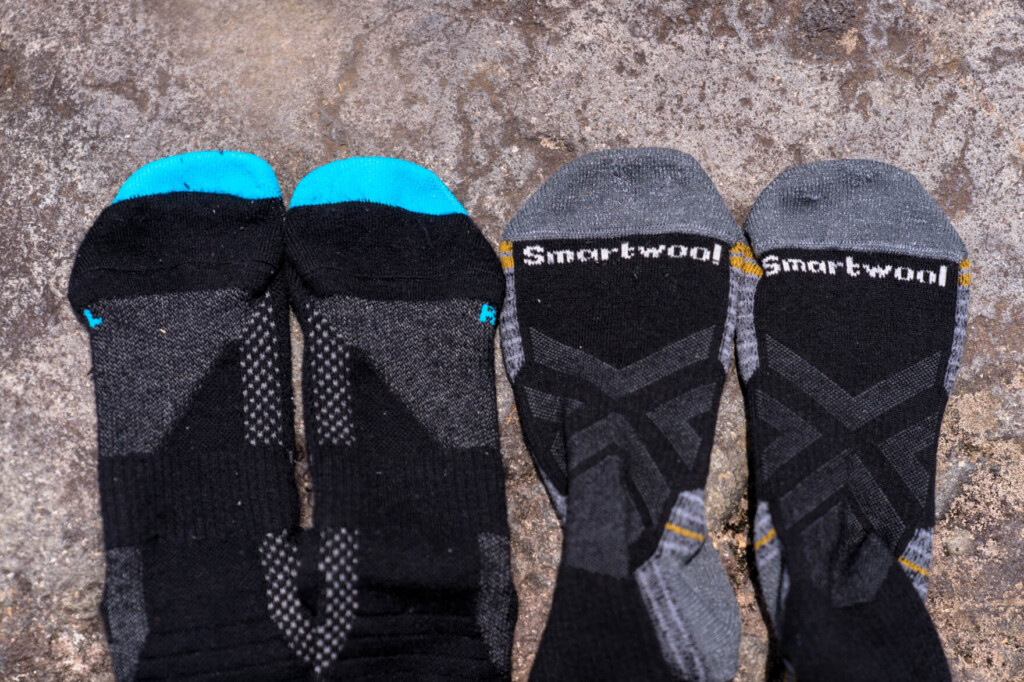
Each person has different foot shapes, so it's not clear whether it's the best until you put your feet in and move them. However, whether or not these ingenuity will definitely increase the chances of encountering Cinderella Fit socks.
By the way, sock sizes are generally roughly available, such as S, M, L, and XL, so depending on the item, your feet may be at the boundary point, which can make you unsure, but in my experience, it seems that if you choose the smaller size if you choose the loose knitted socks (thick type), and if you choose the larger size if you choose the tightly knitted socks, you will lessen your mistakes.
Split tip (two fingers, five fingers) socks
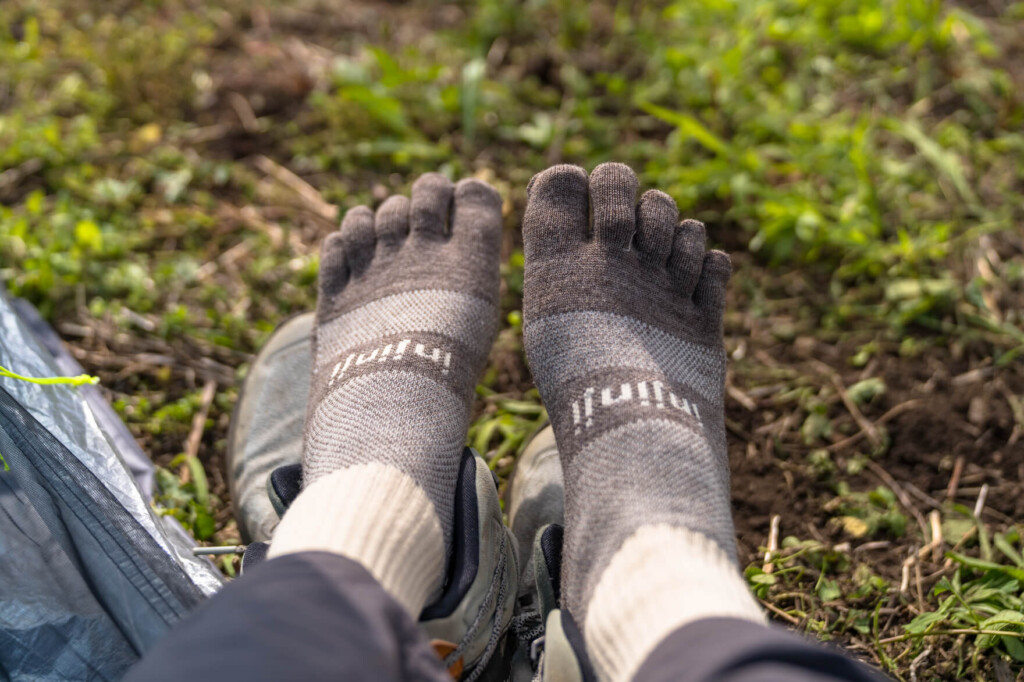
What is the best "five-finger socks" that some have enthusiastic fans? It is said that it has the following advantages:
- It also absorbs sweat between your toes to prevent stuffiness caused by thoroughly absorbing sweat.
- The fingers and fingers do not rub, so it is difficult to make limp.
- The freedom to move your fingers makes it easier to convey your finger strength to the ground.
Personally, the third effect I had never expected, and the feeling of stomping on the ground with bare feet can be strangely addictive. Of course, there are individual differences in how you feel, but if you are currently suffering from the above-mentioned issues, it is definitely worth trying as one of the solutions.
Women's socks
In recent years, many separate models have been sold, for men and women. The major differences are the differences in coloring and size variations, but in most cases there is no significant "performance" difference between the two. However, in terms of fit, there are very small differences, such as the width of the forefoot and heels of women's socks are slightly narrower and the width of the men's socks are wider. This means that if you are a woman who knows that your feet are clearly wider, men's models may fit better, and on the other hand, men with thin heels may get a better fit with women's socks.
Supporter effect and compression socks
In the world of tights and underwear, compression models, which are said to be effective in supporting joint movement and reducing muscle fatigue, have been common for a long time, but in the world of socks, these socks have been developed by some ambitious brands.
Compression socks control blood flow to the calves to reduce swelling, support the arch of the arch and prevent drops, and reduce fatigue from walking long distances and distribute impact, providing additional benefits to improving the fit. Since I learned this, I'm sure I can't let go of a pair of shoes on a trip where there is a chance that I can expect a hard route. However, compared to regular socks, you may be too concerned about the tightness that is much stronger, and it is important to keep in mind that a leisurely trip can actually be stressful.
Of course, this is just my personal opinion, but the compression function is not recommended for everyone. However, it is worth trying at least for those who want high performance or those who are hoping to have long activities.
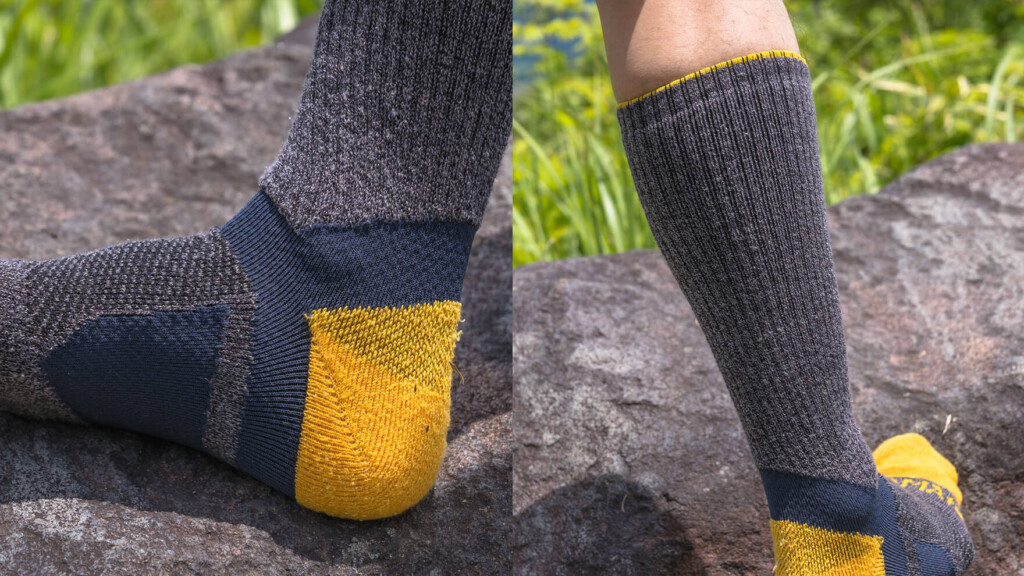
Point 5: Durability - A variety of models, from things that get worn out in one season to models that last forever
Mountain socks are generally resistant to scuffs and snags, but even so, if you use them as much as you want on hiking or running, you will inevitably wear out to some extent. Furthermore, depending on the material, the fibers can also be damaged by washing machines or dryers.
Immediately after I bought the fabric, which was abundant, wears down due to repeated strong friction, and it gets worn out as quickly as possible without lasting a season. The pile fabric gives it the ultimate comfort, but it can be cruelly frayed due to slight carelessness (photo below).

Not only does its strength against scratches and wear vary greatly depending on the brand, but even among the same manufacturers, it varies depending on the age, making it difficult to tell at a glance. However, you should be careful not to be too distracted by the comfort.
However, you must be prepared to wear out some amount of socks. It is wise to use multiple pairs of mountaineering socks as much as possible, and you can expect them to last at least a few years.
Socks guaranteed
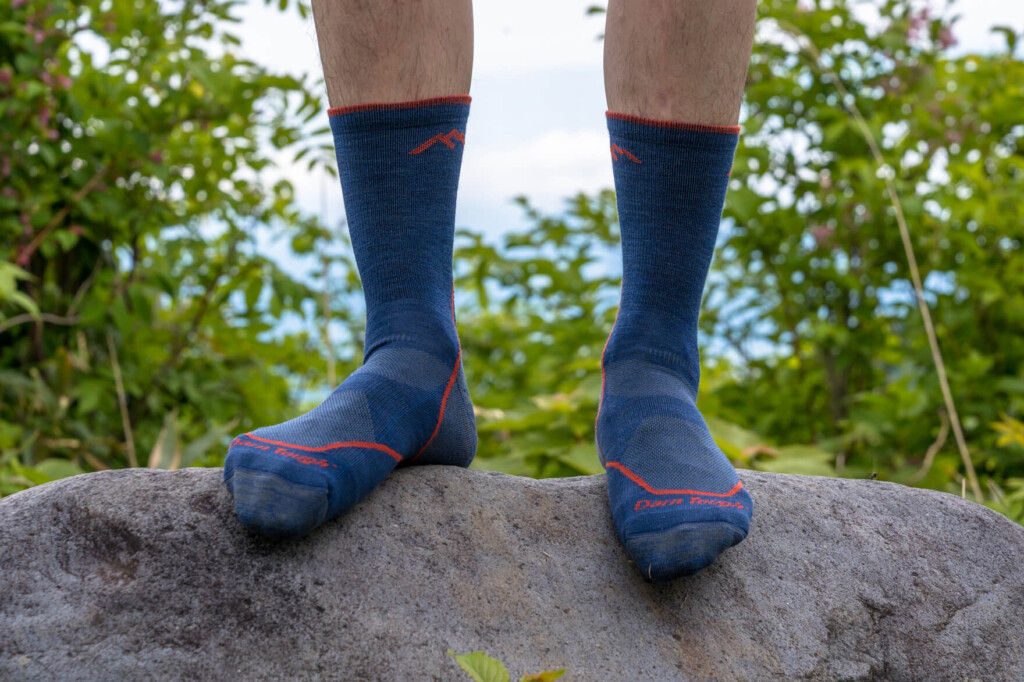
In order to clearly show consumers the durability of socks, which is difficult to judge by their appearance alone, some manufacturers, including the North American sock specialty brand, Darn Tough, which guarantees product damage.
Darntuff's "lifetime warranty" allows for free replacement at any time if holes are made during normal use, as well as manufacturing defects. Following Darntaf, several brands in North America, such as Feetures and FARM TO FEET, have also started to assure quality. Other manufacturers have opposed the company with a fixed period of warranty, with Smartwool being two years (services in their home country) and REI Co-op being one year. This quality assurance is of course not the ultimate decision factor, but it should be a great source of security when purchasing an expensive model. It's a good idea to keep it in the back of your mind.
summary
Socks are trivial items that you might call them "just ◯◯" in everyday life, but when hiking, they are an important tool that you need to consider carefully. The feet and boots vary from person to person, and in that sense, it is difficult to find the right answer that is easy to recommend to everyone when considering activities and seasons, which makes choosing socks complicated. In such cases, I would be happy if you could think of the points mentioned in this guide and use them as a reference when choosing your own socks.
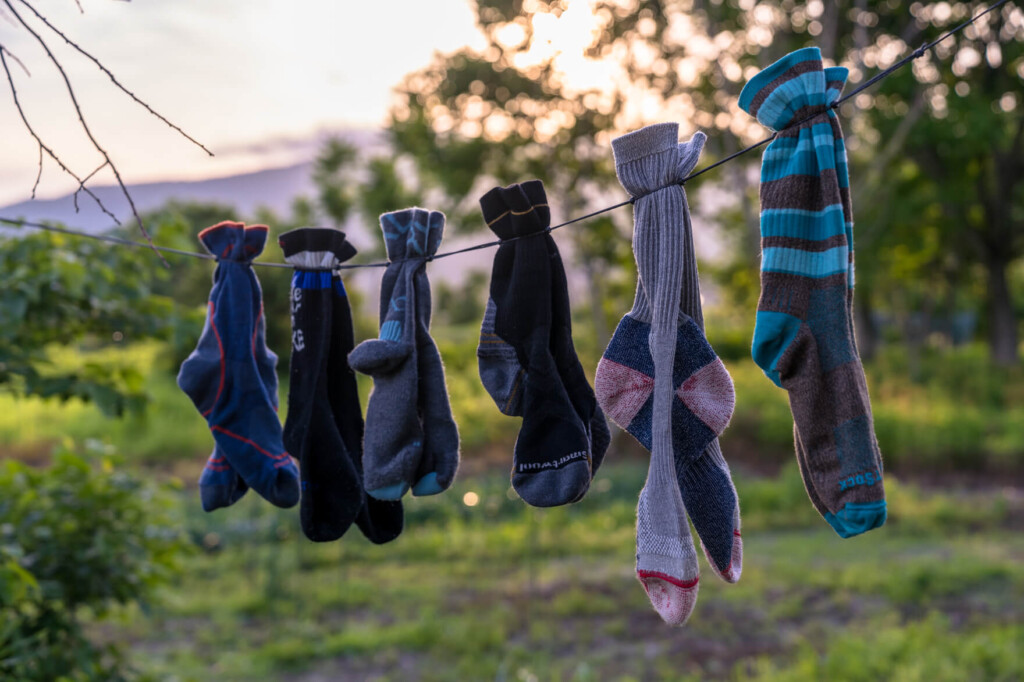


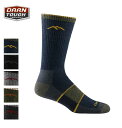



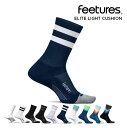




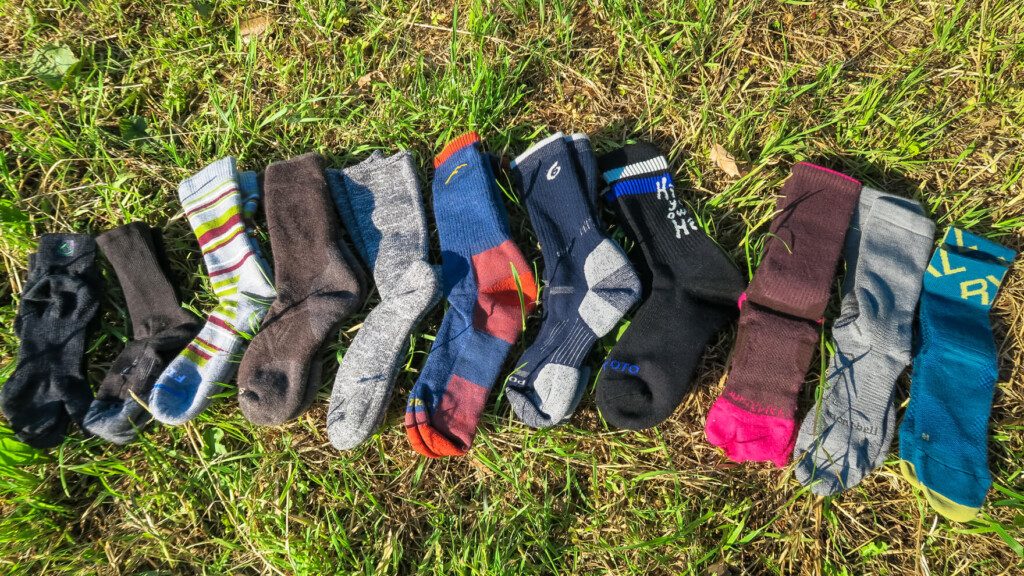 [A self-paying comparison review without consideration] It's important, but they tend to neglect them. A veteran with 30 years of experience in mountain climbing compared 11 models of mountain climbing socks.
[A self-paying comparison review without consideration] It's important, but they tend to neglect them. A veteran with 30 years of experience in mountain climbing compared 11 models of mountain climbing socks.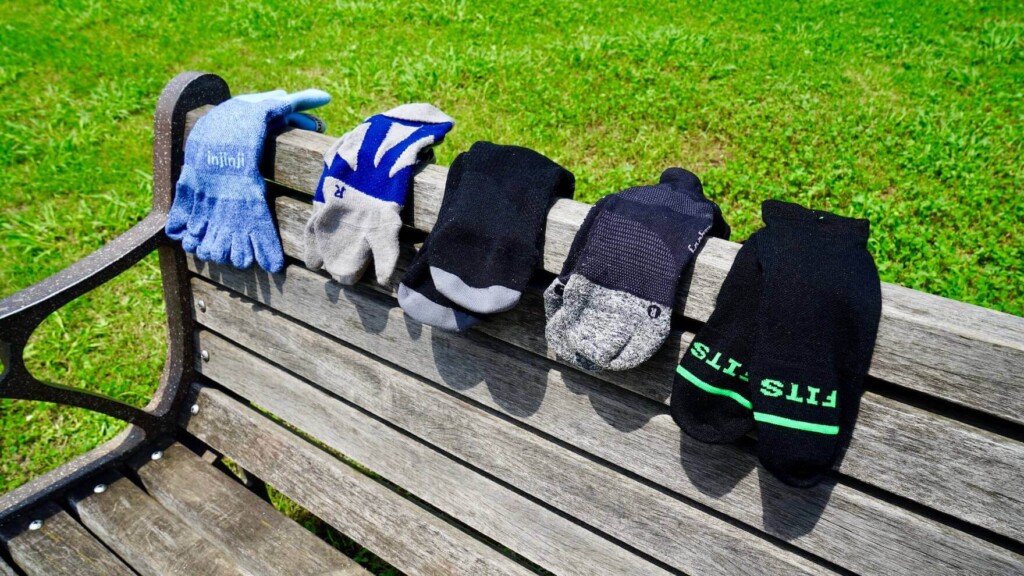 Comparative review: This summer, looking for light socks perfect for fast packing 2019 [for trail runs]
Comparative review: This summer, looking for light socks perfect for fast packing 2019 [for trail runs]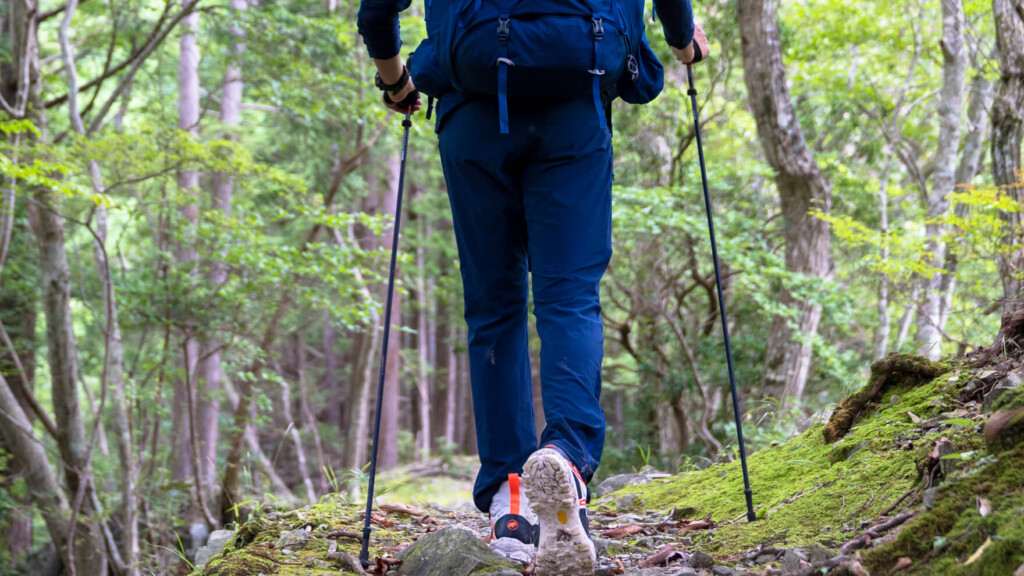 Recommended trekking poles and clever ways to choose from mountain lovers who have compared over 50 of them [Complete Guide]
Recommended trekking poles and clever ways to choose from mountain lovers who have compared over 50 of them [Complete Guide] [I was completely swaying...] Sockwell compression sock review: "Compression high socks" were even better than I thought. I tried out various types and looked for models that are recommended for outdoor activities.
[I was completely swaying...] Sockwell compression sock review: "Compression high socks" were even better than I thought. I tried out various types and looked for models that are recommended for outdoor activities.